Critical Evaluation of Development and Role of Balanced Scorecard
VerifiedAdded on 2019/12/03
|13
|3875
|429
Report
AI Summary
This report provides a critical evaluation of the development and role of the balanced scorecard (BSC) in production and service organizations. The report begins with an introduction to the BSC as a strategic performance tool used for aligning business activities with organizational vision and strategy. It then explores the development of the BSC, highlighting its origins with Kaplan and Norton and its evolution as a strategic management system. The report discusses the steps involved in developing a BSC, including defining a purpose statement, designing a change agenda, creating a strategic map, developing measures, and setting initiatives. It further analyzes the application of BSC in different organizational contexts, providing examples from companies like Apple Computer and Rockwater. The report also includes a critical analysis of the BSC, its role in strategic management, its advantages, and its limitations. Finally, the report concludes with a summary of the key findings and arguments presented throughout the analysis.
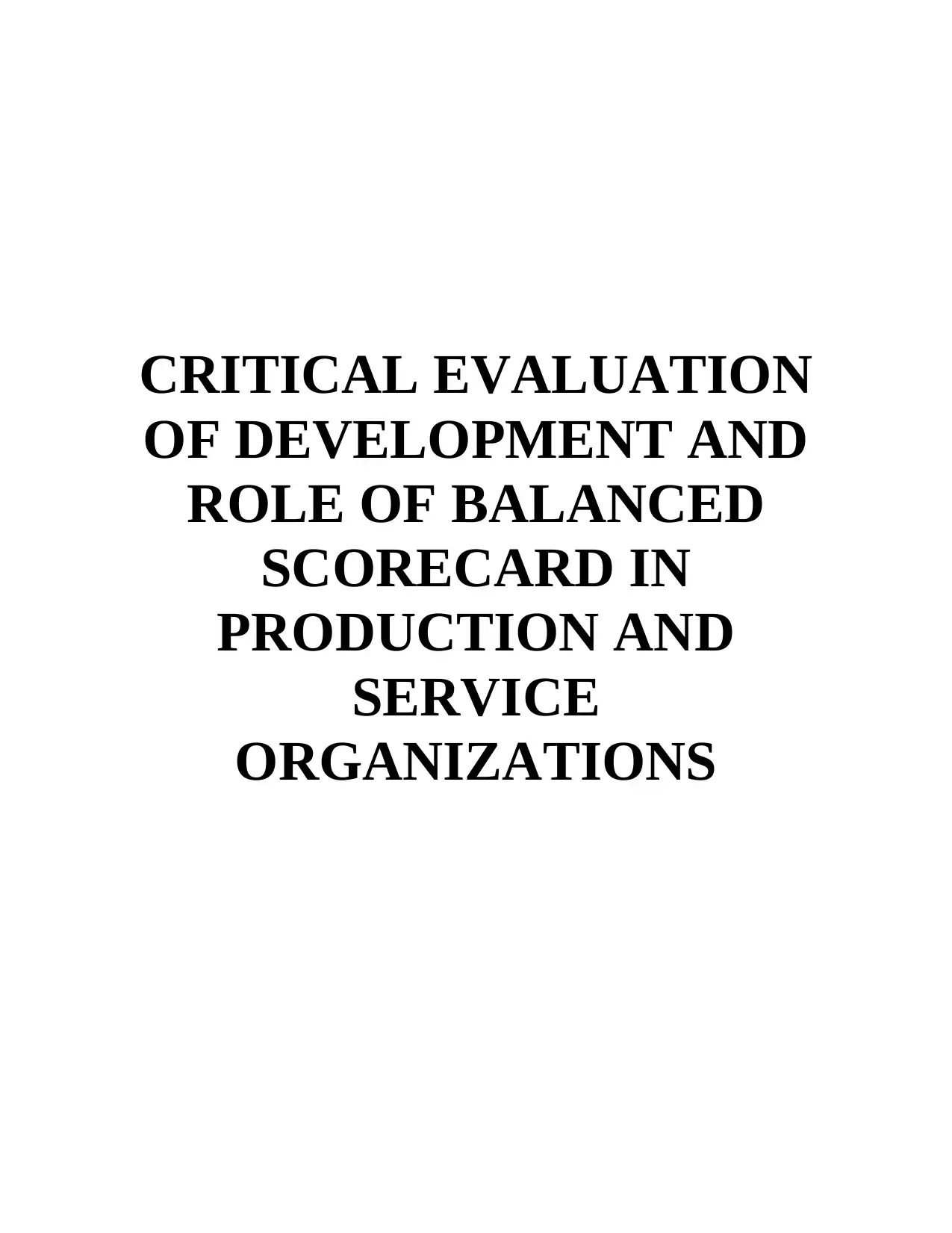
CRITICAL EVALUATION
OF DEVELOPMENT AND
ROLE OF BALANCED
SCORECARD IN
PRODUCTION AND
SERVICE
ORGANIZATIONS
OF DEVELOPMENT AND
ROLE OF BALANCED
SCORECARD IN
PRODUCTION AND
SERVICE
ORGANIZATIONS
Paraphrase This Document
Need a fresh take? Get an instant paraphrase of this document with our AI Paraphraser
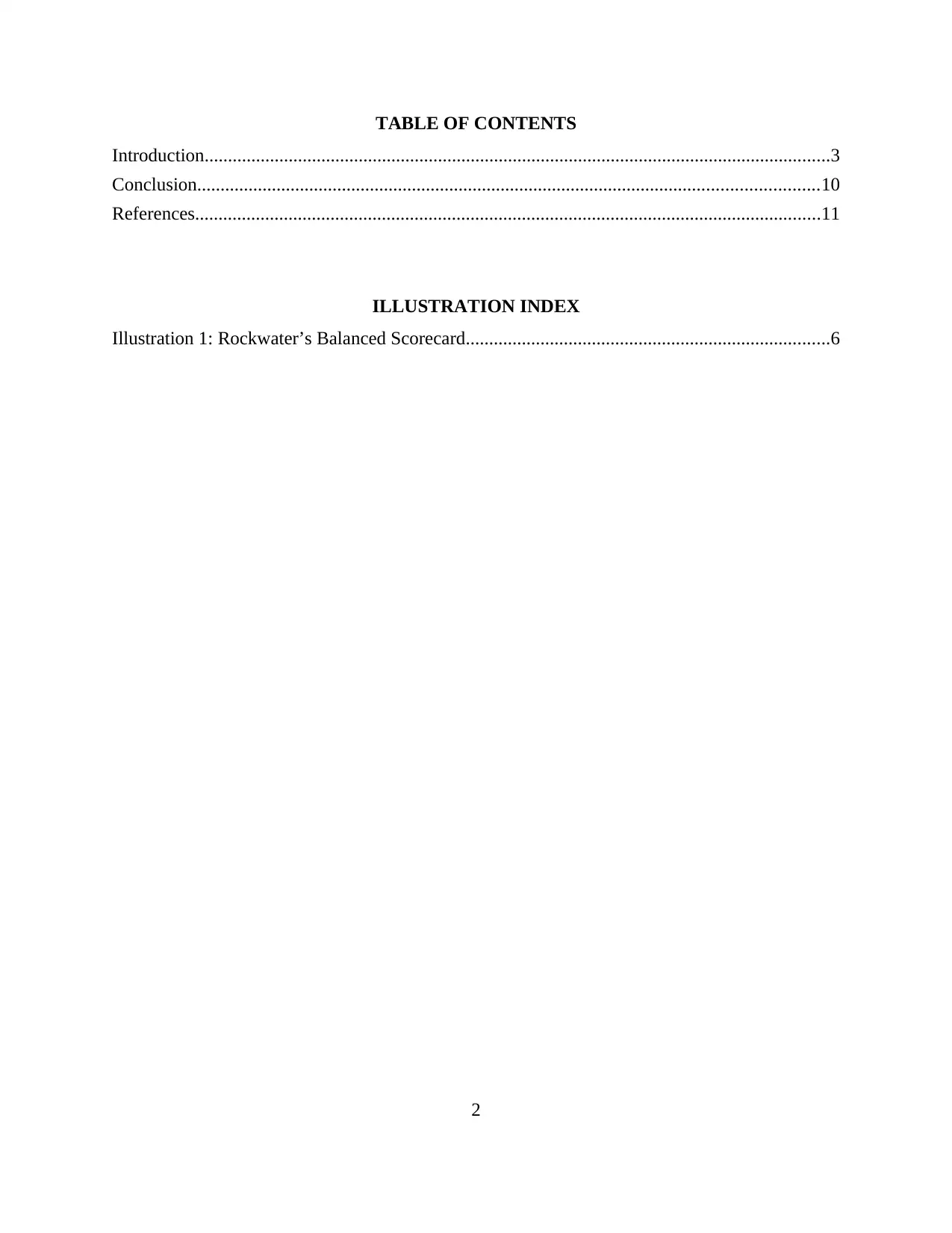
TABLE OF CONTENTS
Introduction......................................................................................................................................3
Conclusion.....................................................................................................................................10
References......................................................................................................................................11
ILLUSTRATION INDEX
Illustration 1: Rockwater’s Balanced Scorecard..............................................................................6
2
Introduction......................................................................................................................................3
Conclusion.....................................................................................................................................10
References......................................................................................................................................11
ILLUSTRATION INDEX
Illustration 1: Rockwater’s Balanced Scorecard..............................................................................6
2
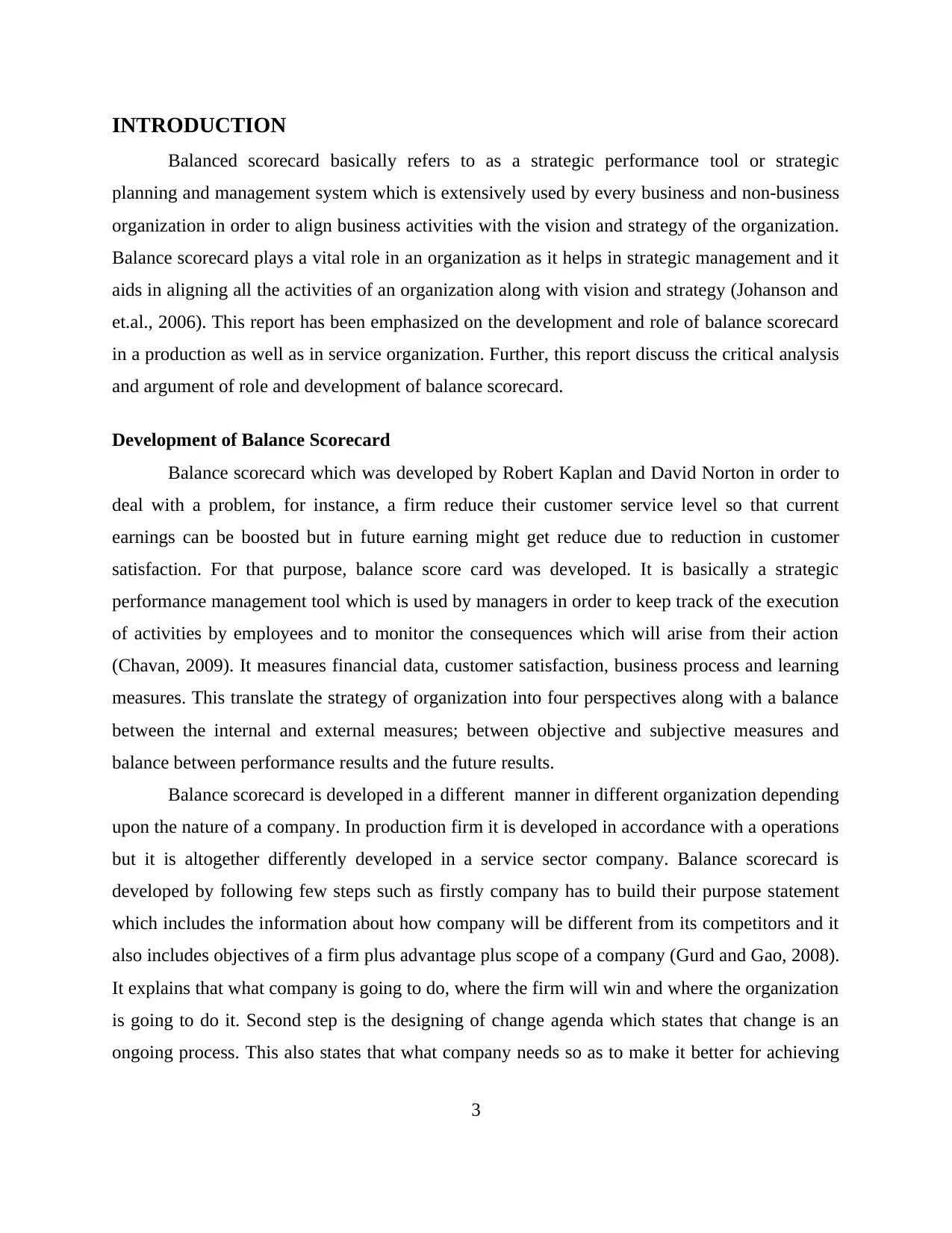
INTRODUCTION
Balanced scorecard basically refers to as a strategic performance tool or strategic
planning and management system which is extensively used by every business and non-business
organization in order to align business activities with the vision and strategy of the organization.
Balance scorecard plays a vital role in an organization as it helps in strategic management and it
aids in aligning all the activities of an organization along with vision and strategy (Johanson and
et.al., 2006). This report has been emphasized on the development and role of balance scorecard
in a production as well as in service organization. Further, this report discuss the critical analysis
and argument of role and development of balance scorecard.
Development of Balance Scorecard
Balance scorecard which was developed by Robert Kaplan and David Norton in order to
deal with a problem, for instance, a firm reduce their customer service level so that current
earnings can be boosted but in future earning might get reduce due to reduction in customer
satisfaction. For that purpose, balance score card was developed. It is basically a strategic
performance management tool which is used by managers in order to keep track of the execution
of activities by employees and to monitor the consequences which will arise from their action
(Chavan, 2009). It measures financial data, customer satisfaction, business process and learning
measures. This translate the strategy of organization into four perspectives along with a balance
between the internal and external measures; between objective and subjective measures and
balance between performance results and the future results.
Balance scorecard is developed in a different manner in different organization depending
upon the nature of a company. In production firm it is developed in accordance with a operations
but it is altogether differently developed in a service sector company. Balance scorecard is
developed by following few steps such as firstly company has to build their purpose statement
which includes the information about how company will be different from its competitors and it
also includes objectives of a firm plus advantage plus scope of a company (Gurd and Gao, 2008).
It explains that what company is going to do, where the firm will win and where the organization
is going to do it. Second step is the designing of change agenda which states that change is an
ongoing process. This also states that what company needs so as to make it better for achieving
3
Balanced scorecard basically refers to as a strategic performance tool or strategic
planning and management system which is extensively used by every business and non-business
organization in order to align business activities with the vision and strategy of the organization.
Balance scorecard plays a vital role in an organization as it helps in strategic management and it
aids in aligning all the activities of an organization along with vision and strategy (Johanson and
et.al., 2006). This report has been emphasized on the development and role of balance scorecard
in a production as well as in service organization. Further, this report discuss the critical analysis
and argument of role and development of balance scorecard.
Development of Balance Scorecard
Balance scorecard which was developed by Robert Kaplan and David Norton in order to
deal with a problem, for instance, a firm reduce their customer service level so that current
earnings can be boosted but in future earning might get reduce due to reduction in customer
satisfaction. For that purpose, balance score card was developed. It is basically a strategic
performance management tool which is used by managers in order to keep track of the execution
of activities by employees and to monitor the consequences which will arise from their action
(Chavan, 2009). It measures financial data, customer satisfaction, business process and learning
measures. This translate the strategy of organization into four perspectives along with a balance
between the internal and external measures; between objective and subjective measures and
balance between performance results and the future results.
Balance scorecard is developed in a different manner in different organization depending
upon the nature of a company. In production firm it is developed in accordance with a operations
but it is altogether differently developed in a service sector company. Balance scorecard is
developed by following few steps such as firstly company has to build their purpose statement
which includes the information about how company will be different from its competitors and it
also includes objectives of a firm plus advantage plus scope of a company (Gurd and Gao, 2008).
It explains that what company is going to do, where the firm will win and where the organization
is going to do it. Second step is the designing of change agenda which states that change is an
ongoing process. This also states that what company needs so as to make it better for achieving
3
⊘ This is a preview!⊘
Do you want full access?
Subscribe today to unlock all pages.

Trusted by 1+ million students worldwide
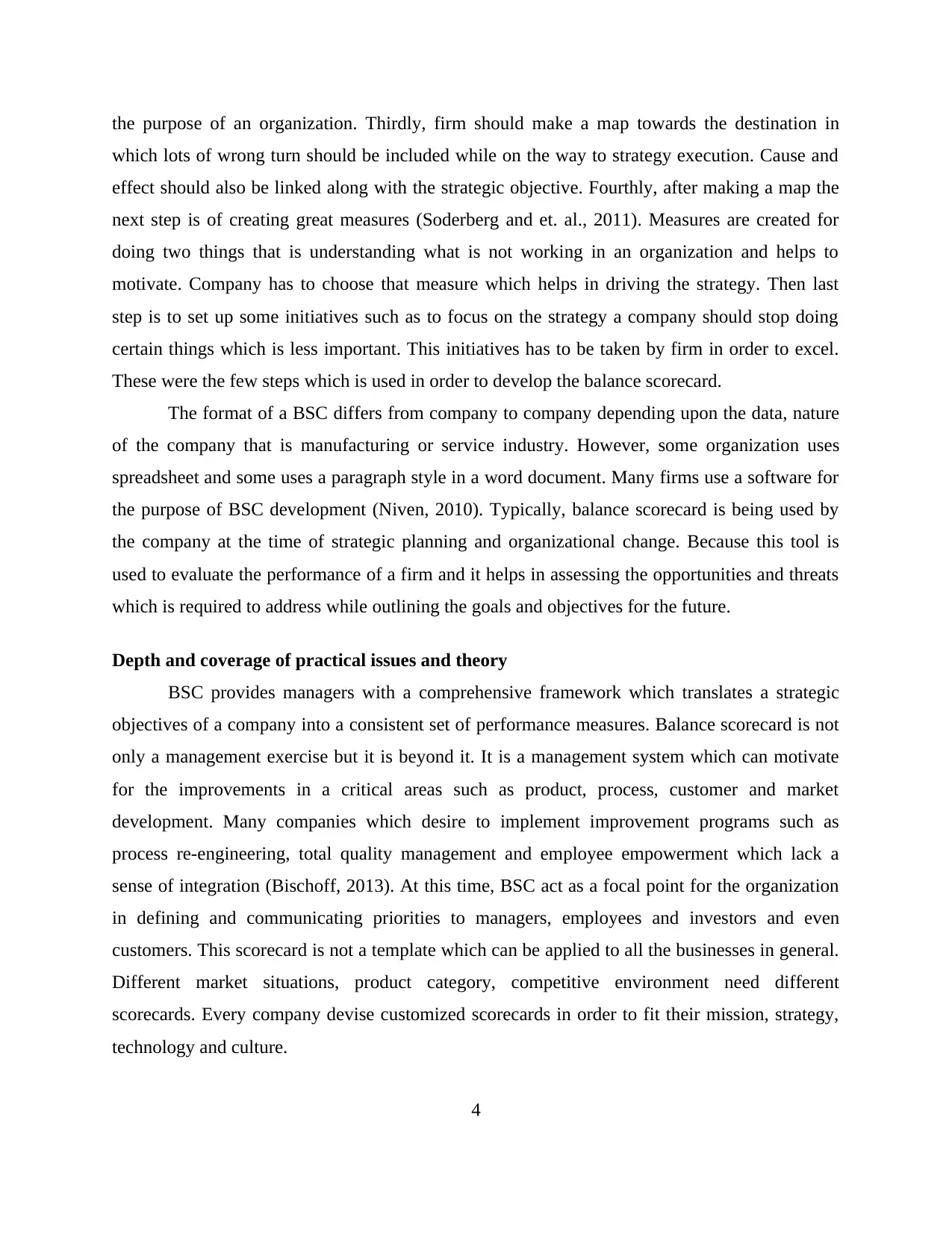
the purpose of an organization. Thirdly, firm should make a map towards the destination in
which lots of wrong turn should be included while on the way to strategy execution. Cause and
effect should also be linked along with the strategic objective. Fourthly, after making a map the
next step is of creating great measures (Soderberg and et. al., 2011). Measures are created for
doing two things that is understanding what is not working in an organization and helps to
motivate. Company has to choose that measure which helps in driving the strategy. Then last
step is to set up some initiatives such as to focus on the strategy a company should stop doing
certain things which is less important. This initiatives has to be taken by firm in order to excel.
These were the few steps which is used in order to develop the balance scorecard.
The format of a BSC differs from company to company depending upon the data, nature
of the company that is manufacturing or service industry. However, some organization uses
spreadsheet and some uses a paragraph style in a word document. Many firms use a software for
the purpose of BSC development (Niven, 2010). Typically, balance scorecard is being used by
the company at the time of strategic planning and organizational change. Because this tool is
used to evaluate the performance of a firm and it helps in assessing the opportunities and threats
which is required to address while outlining the goals and objectives for the future.
Depth and coverage of practical issues and theory
BSC provides managers with a comprehensive framework which translates a strategic
objectives of a company into a consistent set of performance measures. Balance scorecard is not
only a management exercise but it is beyond it. It is a management system which can motivate
for the improvements in a critical areas such as product, process, customer and market
development. Many companies which desire to implement improvement programs such as
process re-engineering, total quality management and employee empowerment which lack a
sense of integration (Bischoff, 2013). At this time, BSC act as a focal point for the organization
in defining and communicating priorities to managers, employees and investors and even
customers. This scorecard is not a template which can be applied to all the businesses in general.
Different market situations, product category, competitive environment need different
scorecards. Every company devise customized scorecards in order to fit their mission, strategy,
technology and culture.
4
which lots of wrong turn should be included while on the way to strategy execution. Cause and
effect should also be linked along with the strategic objective. Fourthly, after making a map the
next step is of creating great measures (Soderberg and et. al., 2011). Measures are created for
doing two things that is understanding what is not working in an organization and helps to
motivate. Company has to choose that measure which helps in driving the strategy. Then last
step is to set up some initiatives such as to focus on the strategy a company should stop doing
certain things which is less important. This initiatives has to be taken by firm in order to excel.
These were the few steps which is used in order to develop the balance scorecard.
The format of a BSC differs from company to company depending upon the data, nature
of the company that is manufacturing or service industry. However, some organization uses
spreadsheet and some uses a paragraph style in a word document. Many firms use a software for
the purpose of BSC development (Niven, 2010). Typically, balance scorecard is being used by
the company at the time of strategic planning and organizational change. Because this tool is
used to evaluate the performance of a firm and it helps in assessing the opportunities and threats
which is required to address while outlining the goals and objectives for the future.
Depth and coverage of practical issues and theory
BSC provides managers with a comprehensive framework which translates a strategic
objectives of a company into a consistent set of performance measures. Balance scorecard is not
only a management exercise but it is beyond it. It is a management system which can motivate
for the improvements in a critical areas such as product, process, customer and market
development. Many companies which desire to implement improvement programs such as
process re-engineering, total quality management and employee empowerment which lack a
sense of integration (Bischoff, 2013). At this time, BSC act as a focal point for the organization
in defining and communicating priorities to managers, employees and investors and even
customers. This scorecard is not a template which can be applied to all the businesses in general.
Different market situations, product category, competitive environment need different
scorecards. Every company devise customized scorecards in order to fit their mission, strategy,
technology and culture.
4
Paraphrase This Document
Need a fresh take? Get an instant paraphrase of this document with our AI Paraphraser
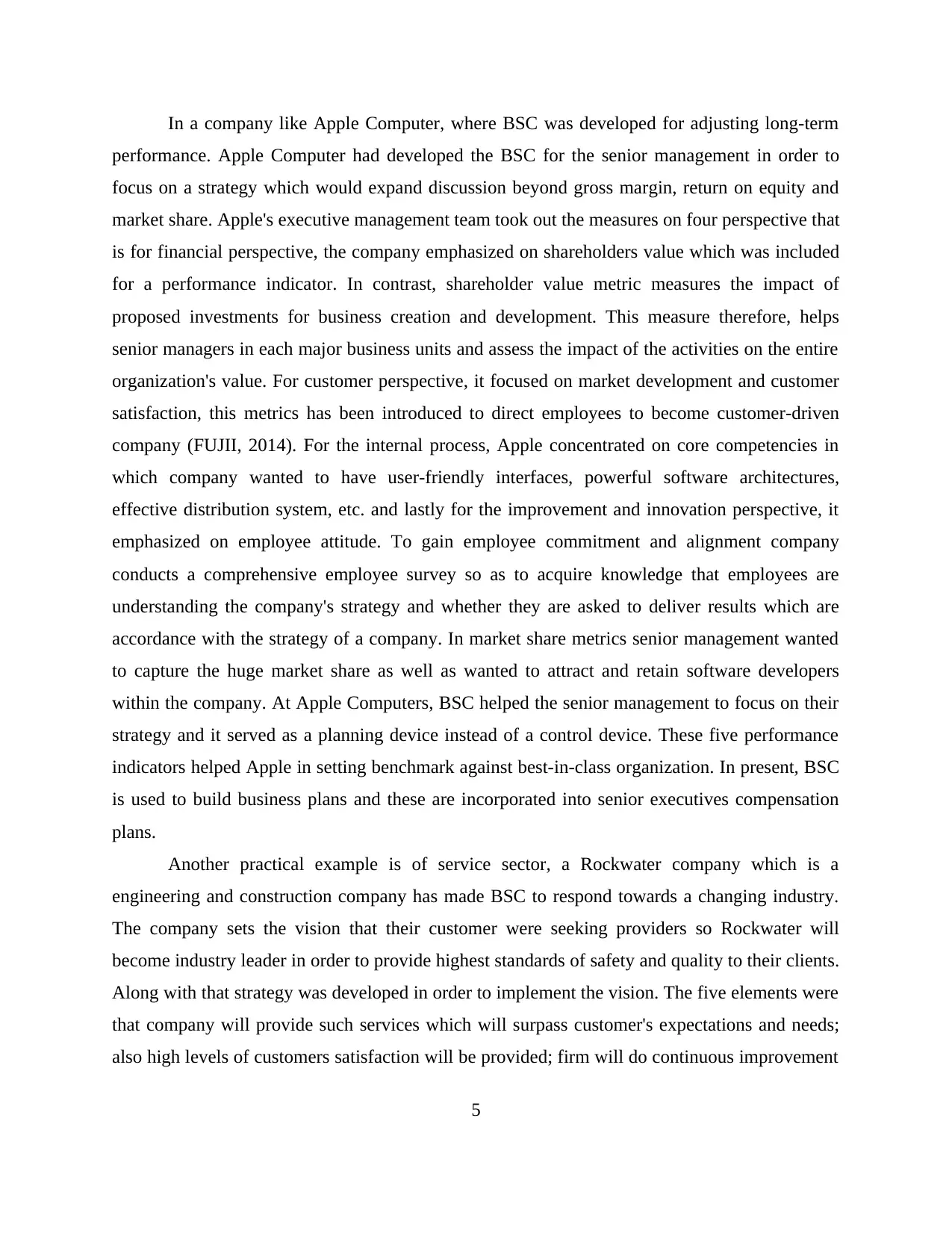
In a company like Apple Computer, where BSC was developed for adjusting long-term
performance. Apple Computer had developed the BSC for the senior management in order to
focus on a strategy which would expand discussion beyond gross margin, return on equity and
market share. Apple's executive management team took out the measures on four perspective that
is for financial perspective, the company emphasized on shareholders value which was included
for a performance indicator. In contrast, shareholder value metric measures the impact of
proposed investments for business creation and development. This measure therefore, helps
senior managers in each major business units and assess the impact of the activities on the entire
organization's value. For customer perspective, it focused on market development and customer
satisfaction, this metrics has been introduced to direct employees to become customer-driven
company (FUJII, 2014). For the internal process, Apple concentrated on core competencies in
which company wanted to have user-friendly interfaces, powerful software architectures,
effective distribution system, etc. and lastly for the improvement and innovation perspective, it
emphasized on employee attitude. To gain employee commitment and alignment company
conducts a comprehensive employee survey so as to acquire knowledge that employees are
understanding the company's strategy and whether they are asked to deliver results which are
accordance with the strategy of a company. In market share metrics senior management wanted
to capture the huge market share as well as wanted to attract and retain software developers
within the company. At Apple Computers, BSC helped the senior management to focus on their
strategy and it served as a planning device instead of a control device. These five performance
indicators helped Apple in setting benchmark against best-in-class organization. In present, BSC
is used to build business plans and these are incorporated into senior executives compensation
plans.
Another practical example is of service sector, a Rockwater company which is a
engineering and construction company has made BSC to respond towards a changing industry.
The company sets the vision that their customer were seeking providers so Rockwater will
become industry leader in order to provide highest standards of safety and quality to their clients.
Along with that strategy was developed in order to implement the vision. The five elements were
that company will provide such services which will surpass customer's expectations and needs;
also high levels of customers satisfaction will be provided; firm will do continuous improvement
5
performance. Apple Computer had developed the BSC for the senior management in order to
focus on a strategy which would expand discussion beyond gross margin, return on equity and
market share. Apple's executive management team took out the measures on four perspective that
is for financial perspective, the company emphasized on shareholders value which was included
for a performance indicator. In contrast, shareholder value metric measures the impact of
proposed investments for business creation and development. This measure therefore, helps
senior managers in each major business units and assess the impact of the activities on the entire
organization's value. For customer perspective, it focused on market development and customer
satisfaction, this metrics has been introduced to direct employees to become customer-driven
company (FUJII, 2014). For the internal process, Apple concentrated on core competencies in
which company wanted to have user-friendly interfaces, powerful software architectures,
effective distribution system, etc. and lastly for the improvement and innovation perspective, it
emphasized on employee attitude. To gain employee commitment and alignment company
conducts a comprehensive employee survey so as to acquire knowledge that employees are
understanding the company's strategy and whether they are asked to deliver results which are
accordance with the strategy of a company. In market share metrics senior management wanted
to capture the huge market share as well as wanted to attract and retain software developers
within the company. At Apple Computers, BSC helped the senior management to focus on their
strategy and it served as a planning device instead of a control device. These five performance
indicators helped Apple in setting benchmark against best-in-class organization. In present, BSC
is used to build business plans and these are incorporated into senior executives compensation
plans.
Another practical example is of service sector, a Rockwater company which is a
engineering and construction company has made BSC to respond towards a changing industry.
The company sets the vision that their customer were seeking providers so Rockwater will
become industry leader in order to provide highest standards of safety and quality to their clients.
Along with that strategy was developed in order to implement the vision. The five elements were
that company will provide such services which will surpass customer's expectations and needs;
also high levels of customers satisfaction will be provided; firm will do continuous improvement
5
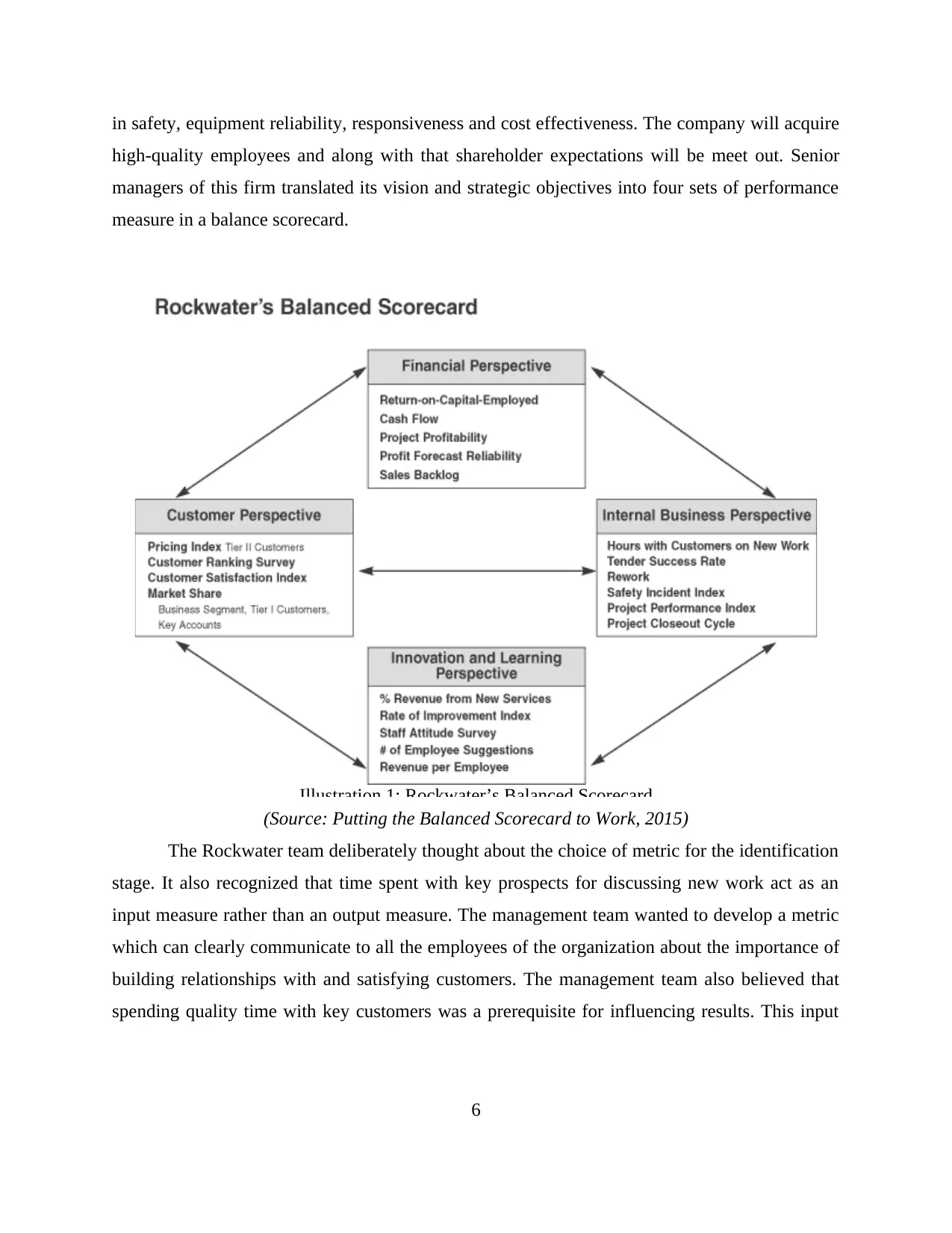
in safety, equipment reliability, responsiveness and cost effectiveness. The company will acquire
high-quality employees and along with that shareholder expectations will be meet out. Senior
managers of this firm translated its vision and strategic objectives into four sets of performance
measure in a balance scorecard.
(Source: Putting the Balanced Scorecard to Work, 2015)
The Rockwater team deliberately thought about the choice of metric for the identification
stage. It also recognized that time spent with key prospects for discussing new work act as an
input measure rather than an output measure. The management team wanted to develop a metric
which can clearly communicate to all the employees of the organization about the importance of
building relationships with and satisfying customers. The management team also believed that
spending quality time with key customers was a prerequisite for influencing results. This input
6
Illustration 1: Rockwater’s Balanced Scorecard
high-quality employees and along with that shareholder expectations will be meet out. Senior
managers of this firm translated its vision and strategic objectives into four sets of performance
measure in a balance scorecard.
(Source: Putting the Balanced Scorecard to Work, 2015)
The Rockwater team deliberately thought about the choice of metric for the identification
stage. It also recognized that time spent with key prospects for discussing new work act as an
input measure rather than an output measure. The management team wanted to develop a metric
which can clearly communicate to all the employees of the organization about the importance of
building relationships with and satisfying customers. The management team also believed that
spending quality time with key customers was a prerequisite for influencing results. This input
6
Illustration 1: Rockwater’s Balanced Scorecard
⊘ This is a preview!⊘
Do you want full access?
Subscribe today to unlock all pages.

Trusted by 1+ million students worldwide
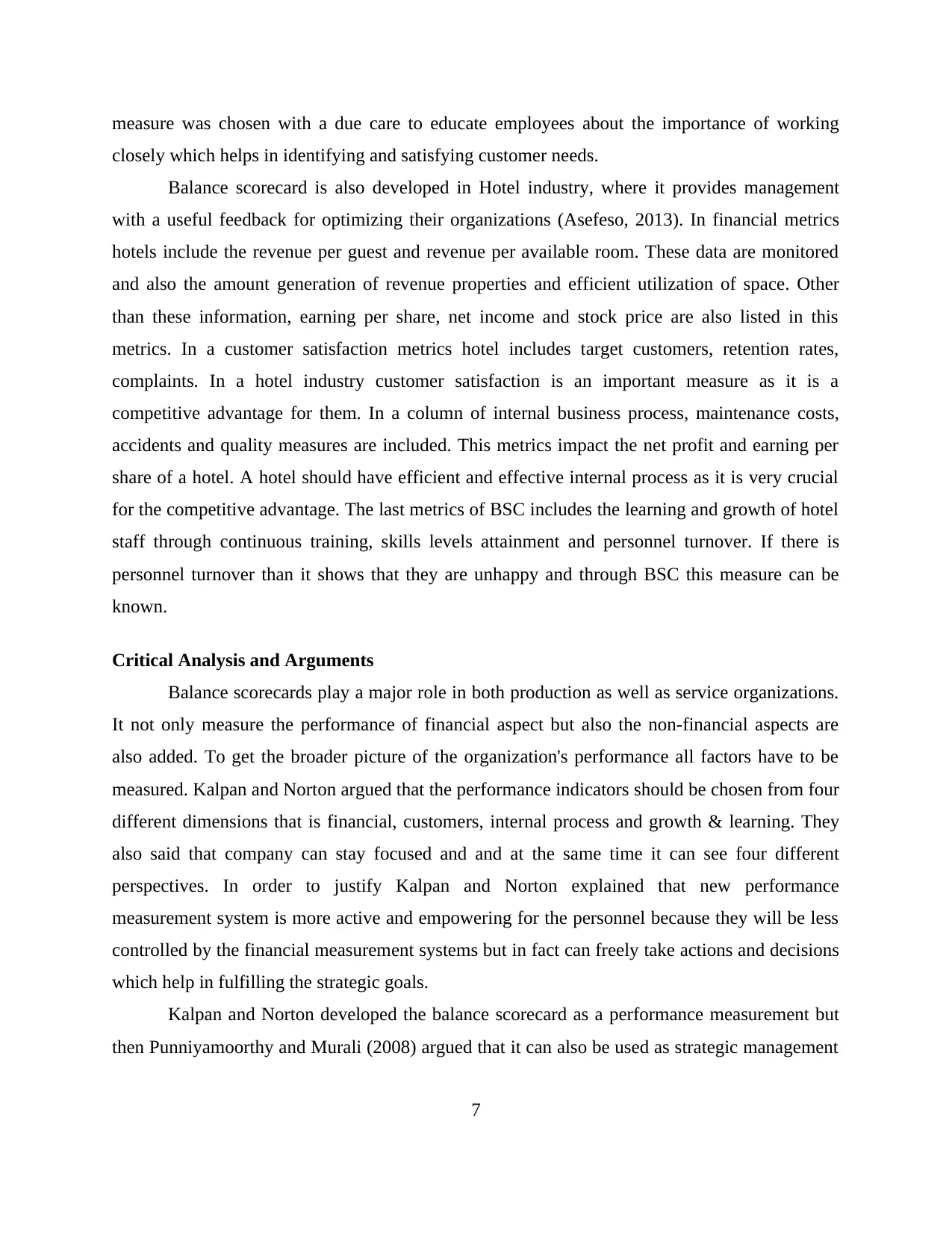
measure was chosen with a due care to educate employees about the importance of working
closely which helps in identifying and satisfying customer needs.
Balance scorecard is also developed in Hotel industry, where it provides management
with a useful feedback for optimizing their organizations (Asefeso, 2013). In financial metrics
hotels include the revenue per guest and revenue per available room. These data are monitored
and also the amount generation of revenue properties and efficient utilization of space. Other
than these information, earning per share, net income and stock price are also listed in this
metrics. In a customer satisfaction metrics hotel includes target customers, retention rates,
complaints. In a hotel industry customer satisfaction is an important measure as it is a
competitive advantage for them. In a column of internal business process, maintenance costs,
accidents and quality measures are included. This metrics impact the net profit and earning per
share of a hotel. A hotel should have efficient and effective internal process as it is very crucial
for the competitive advantage. The last metrics of BSC includes the learning and growth of hotel
staff through continuous training, skills levels attainment and personnel turnover. If there is
personnel turnover than it shows that they are unhappy and through BSC this measure can be
known.
Critical Analysis and Arguments
Balance scorecards play a major role in both production as well as service organizations.
It not only measure the performance of financial aspect but also the non-financial aspects are
also added. To get the broader picture of the organization's performance all factors have to be
measured. Kalpan and Norton argued that the performance indicators should be chosen from four
different dimensions that is financial, customers, internal process and growth & learning. They
also said that company can stay focused and and at the same time it can see four different
perspectives. In order to justify Kalpan and Norton explained that new performance
measurement system is more active and empowering for the personnel because they will be less
controlled by the financial measurement systems but in fact can freely take actions and decisions
which help in fulfilling the strategic goals.
Kalpan and Norton developed the balance scorecard as a performance measurement but
then Punniyamoorthy and Murali (2008) argued that it can also be used as strategic management
7
closely which helps in identifying and satisfying customer needs.
Balance scorecard is also developed in Hotel industry, where it provides management
with a useful feedback for optimizing their organizations (Asefeso, 2013). In financial metrics
hotels include the revenue per guest and revenue per available room. These data are monitored
and also the amount generation of revenue properties and efficient utilization of space. Other
than these information, earning per share, net income and stock price are also listed in this
metrics. In a customer satisfaction metrics hotel includes target customers, retention rates,
complaints. In a hotel industry customer satisfaction is an important measure as it is a
competitive advantage for them. In a column of internal business process, maintenance costs,
accidents and quality measures are included. This metrics impact the net profit and earning per
share of a hotel. A hotel should have efficient and effective internal process as it is very crucial
for the competitive advantage. The last metrics of BSC includes the learning and growth of hotel
staff through continuous training, skills levels attainment and personnel turnover. If there is
personnel turnover than it shows that they are unhappy and through BSC this measure can be
known.
Critical Analysis and Arguments
Balance scorecards play a major role in both production as well as service organizations.
It not only measure the performance of financial aspect but also the non-financial aspects are
also added. To get the broader picture of the organization's performance all factors have to be
measured. Kalpan and Norton argued that the performance indicators should be chosen from four
different dimensions that is financial, customers, internal process and growth & learning. They
also said that company can stay focused and and at the same time it can see four different
perspectives. In order to justify Kalpan and Norton explained that new performance
measurement system is more active and empowering for the personnel because they will be less
controlled by the financial measurement systems but in fact can freely take actions and decisions
which help in fulfilling the strategic goals.
Kalpan and Norton developed the balance scorecard as a performance measurement but
then Punniyamoorthy and Murali (2008) argued that it can also be used as strategic management
7
Paraphrase This Document
Need a fresh take? Get an instant paraphrase of this document with our AI Paraphraser
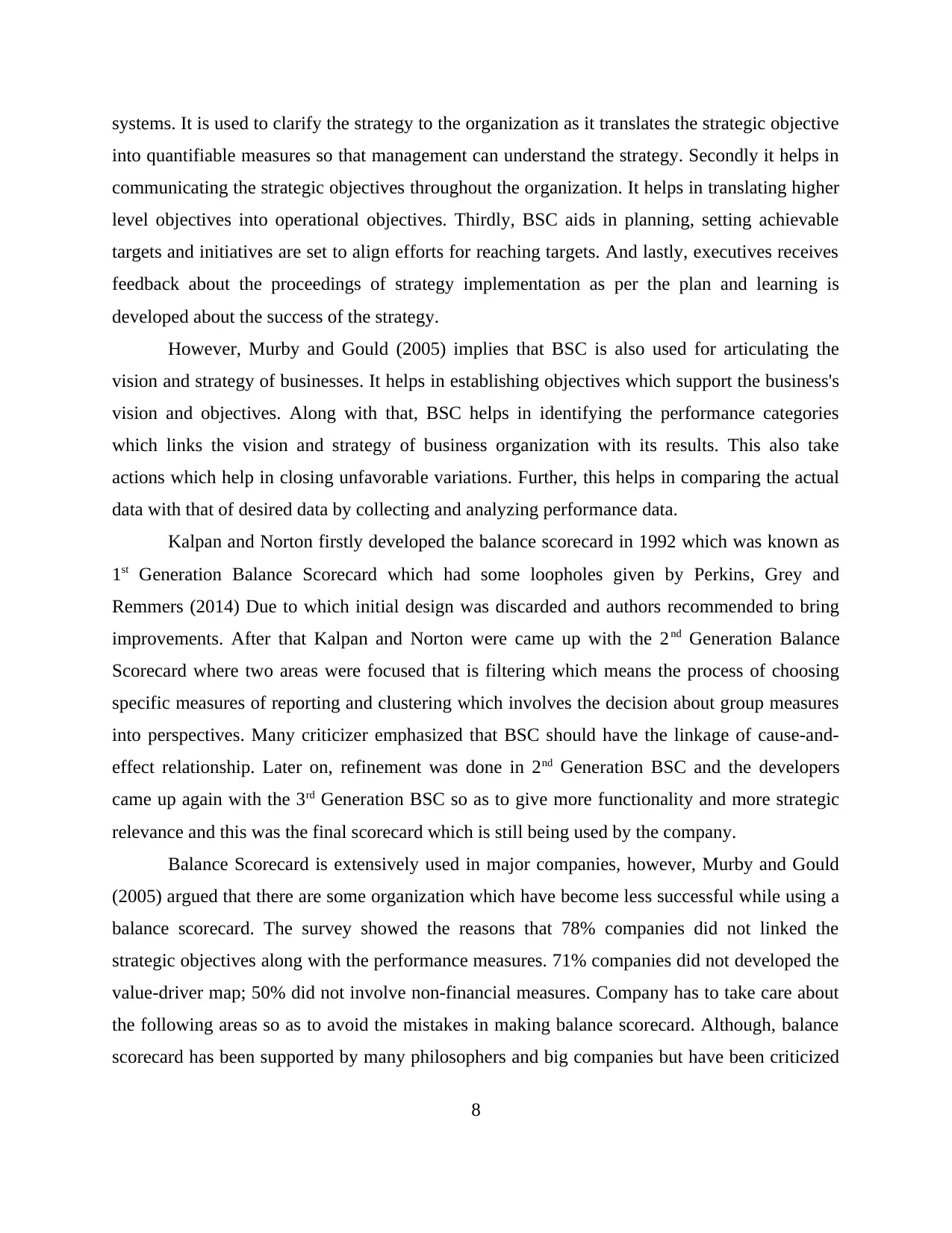
systems. It is used to clarify the strategy to the organization as it translates the strategic objective
into quantifiable measures so that management can understand the strategy. Secondly it helps in
communicating the strategic objectives throughout the organization. It helps in translating higher
level objectives into operational objectives. Thirdly, BSC aids in planning, setting achievable
targets and initiatives are set to align efforts for reaching targets. And lastly, executives receives
feedback about the proceedings of strategy implementation as per the plan and learning is
developed about the success of the strategy.
However, Murby and Gould (2005) implies that BSC is also used for articulating the
vision and strategy of businesses. It helps in establishing objectives which support the business's
vision and objectives. Along with that, BSC helps in identifying the performance categories
which links the vision and strategy of business organization with its results. This also take
actions which help in closing unfavorable variations. Further, this helps in comparing the actual
data with that of desired data by collecting and analyzing performance data.
Kalpan and Norton firstly developed the balance scorecard in 1992 which was known as
1st Generation Balance Scorecard which had some loopholes given by Perkins, Grey and
Remmers (2014) Due to which initial design was discarded and authors recommended to bring
improvements. After that Kalpan and Norton were came up with the 2nd Generation Balance
Scorecard where two areas were focused that is filtering which means the process of choosing
specific measures of reporting and clustering which involves the decision about group measures
into perspectives. Many criticizer emphasized that BSC should have the linkage of cause-and-
effect relationship. Later on, refinement was done in 2nd Generation BSC and the developers
came up again with the 3rd Generation BSC so as to give more functionality and more strategic
relevance and this was the final scorecard which is still being used by the company.
Balance Scorecard is extensively used in major companies, however, Murby and Gould
(2005) argued that there are some organization which have become less successful while using a
balance scorecard. The survey showed the reasons that 78% companies did not linked the
strategic objectives along with the performance measures. 71% companies did not developed the
value-driver map; 50% did not involve non-financial measures. Company has to take care about
the following areas so as to avoid the mistakes in making balance scorecard. Although, balance
scorecard has been supported by many philosophers and big companies but have been criticized
8
into quantifiable measures so that management can understand the strategy. Secondly it helps in
communicating the strategic objectives throughout the organization. It helps in translating higher
level objectives into operational objectives. Thirdly, BSC aids in planning, setting achievable
targets and initiatives are set to align efforts for reaching targets. And lastly, executives receives
feedback about the proceedings of strategy implementation as per the plan and learning is
developed about the success of the strategy.
However, Murby and Gould (2005) implies that BSC is also used for articulating the
vision and strategy of businesses. It helps in establishing objectives which support the business's
vision and objectives. Along with that, BSC helps in identifying the performance categories
which links the vision and strategy of business organization with its results. This also take
actions which help in closing unfavorable variations. Further, this helps in comparing the actual
data with that of desired data by collecting and analyzing performance data.
Kalpan and Norton firstly developed the balance scorecard in 1992 which was known as
1st Generation Balance Scorecard which had some loopholes given by Perkins, Grey and
Remmers (2014) Due to which initial design was discarded and authors recommended to bring
improvements. After that Kalpan and Norton were came up with the 2nd Generation Balance
Scorecard where two areas were focused that is filtering which means the process of choosing
specific measures of reporting and clustering which involves the decision about group measures
into perspectives. Many criticizer emphasized that BSC should have the linkage of cause-and-
effect relationship. Later on, refinement was done in 2nd Generation BSC and the developers
came up again with the 3rd Generation BSC so as to give more functionality and more strategic
relevance and this was the final scorecard which is still being used by the company.
Balance Scorecard is extensively used in major companies, however, Murby and Gould
(2005) argued that there are some organization which have become less successful while using a
balance scorecard. The survey showed the reasons that 78% companies did not linked the
strategic objectives along with the performance measures. 71% companies did not developed the
value-driver map; 50% did not involve non-financial measures. Company has to take care about
the following areas so as to avoid the mistakes in making balance scorecard. Although, balance
scorecard has been supported by many philosophers and big companies but have been criticized
8
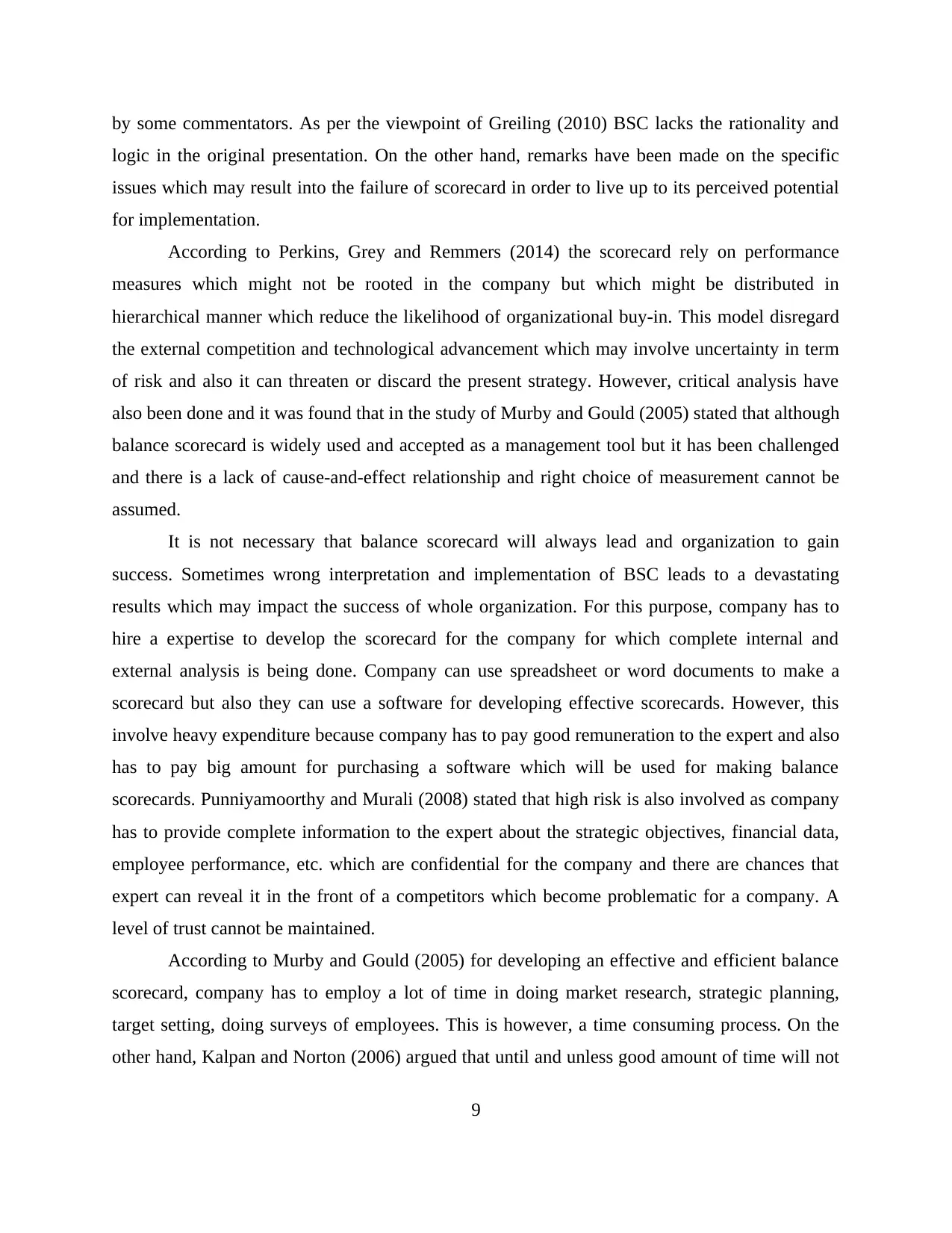
by some commentators. As per the viewpoint of Greiling (2010) BSC lacks the rationality and
logic in the original presentation. On the other hand, remarks have been made on the specific
issues which may result into the failure of scorecard in order to live up to its perceived potential
for implementation.
According to Perkins, Grey and Remmers (2014) the scorecard rely on performance
measures which might not be rooted in the company but which might be distributed in
hierarchical manner which reduce the likelihood of organizational buy-in. This model disregard
the external competition and technological advancement which may involve uncertainty in term
of risk and also it can threaten or discard the present strategy. However, critical analysis have
also been done and it was found that in the study of Murby and Gould (2005) stated that although
balance scorecard is widely used and accepted as a management tool but it has been challenged
and there is a lack of cause-and-effect relationship and right choice of measurement cannot be
assumed.
It is not necessary that balance scorecard will always lead and organization to gain
success. Sometimes wrong interpretation and implementation of BSC leads to a devastating
results which may impact the success of whole organization. For this purpose, company has to
hire a expertise to develop the scorecard for the company for which complete internal and
external analysis is being done. Company can use spreadsheet or word documents to make a
scorecard but also they can use a software for developing effective scorecards. However, this
involve heavy expenditure because company has to pay good remuneration to the expert and also
has to pay big amount for purchasing a software which will be used for making balance
scorecards. Punniyamoorthy and Murali (2008) stated that high risk is also involved as company
has to provide complete information to the expert about the strategic objectives, financial data,
employee performance, etc. which are confidential for the company and there are chances that
expert can reveal it in the front of a competitors which become problematic for a company. A
level of trust cannot be maintained.
According to Murby and Gould (2005) for developing an effective and efficient balance
scorecard, company has to employ a lot of time in doing market research, strategic planning,
target setting, doing surveys of employees. This is however, a time consuming process. On the
other hand, Kalpan and Norton (2006) argued that until and unless good amount of time will not
9
logic in the original presentation. On the other hand, remarks have been made on the specific
issues which may result into the failure of scorecard in order to live up to its perceived potential
for implementation.
According to Perkins, Grey and Remmers (2014) the scorecard rely on performance
measures which might not be rooted in the company but which might be distributed in
hierarchical manner which reduce the likelihood of organizational buy-in. This model disregard
the external competition and technological advancement which may involve uncertainty in term
of risk and also it can threaten or discard the present strategy. However, critical analysis have
also been done and it was found that in the study of Murby and Gould (2005) stated that although
balance scorecard is widely used and accepted as a management tool but it has been challenged
and there is a lack of cause-and-effect relationship and right choice of measurement cannot be
assumed.
It is not necessary that balance scorecard will always lead and organization to gain
success. Sometimes wrong interpretation and implementation of BSC leads to a devastating
results which may impact the success of whole organization. For this purpose, company has to
hire a expertise to develop the scorecard for the company for which complete internal and
external analysis is being done. Company can use spreadsheet or word documents to make a
scorecard but also they can use a software for developing effective scorecards. However, this
involve heavy expenditure because company has to pay good remuneration to the expert and also
has to pay big amount for purchasing a software which will be used for making balance
scorecards. Punniyamoorthy and Murali (2008) stated that high risk is also involved as company
has to provide complete information to the expert about the strategic objectives, financial data,
employee performance, etc. which are confidential for the company and there are chances that
expert can reveal it in the front of a competitors which become problematic for a company. A
level of trust cannot be maintained.
According to Murby and Gould (2005) for developing an effective and efficient balance
scorecard, company has to employ a lot of time in doing market research, strategic planning,
target setting, doing surveys of employees. This is however, a time consuming process. On the
other hand, Kalpan and Norton (2006) argued that until and unless good amount of time will not
9
⊘ This is a preview!⊘
Do you want full access?
Subscribe today to unlock all pages.

Trusted by 1+ million students worldwide
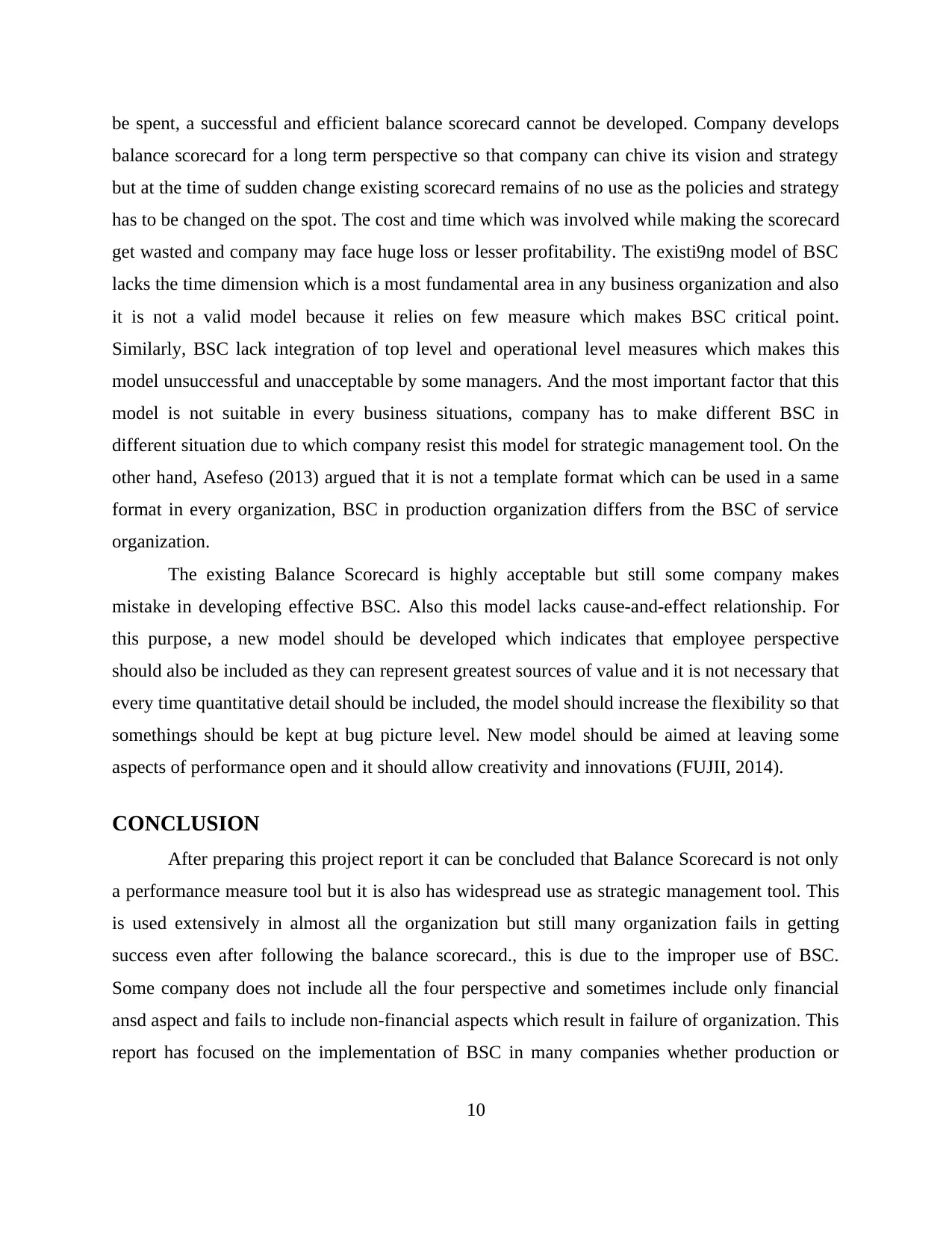
be spent, a successful and efficient balance scorecard cannot be developed. Company develops
balance scorecard for a long term perspective so that company can chive its vision and strategy
but at the time of sudden change existing scorecard remains of no use as the policies and strategy
has to be changed on the spot. The cost and time which was involved while making the scorecard
get wasted and company may face huge loss or lesser profitability. The existi9ng model of BSC
lacks the time dimension which is a most fundamental area in any business organization and also
it is not a valid model because it relies on few measure which makes BSC critical point.
Similarly, BSC lack integration of top level and operational level measures which makes this
model unsuccessful and unacceptable by some managers. And the most important factor that this
model is not suitable in every business situations, company has to make different BSC in
different situation due to which company resist this model for strategic management tool. On the
other hand, Asefeso (2013) argued that it is not a template format which can be used in a same
format in every organization, BSC in production organization differs from the BSC of service
organization.
The existing Balance Scorecard is highly acceptable but still some company makes
mistake in developing effective BSC. Also this model lacks cause-and-effect relationship. For
this purpose, a new model should be developed which indicates that employee perspective
should also be included as they can represent greatest sources of value and it is not necessary that
every time quantitative detail should be included, the model should increase the flexibility so that
somethings should be kept at bug picture level. New model should be aimed at leaving some
aspects of performance open and it should allow creativity and innovations (FUJII, 2014).
CONCLUSION
After preparing this project report it can be concluded that Balance Scorecard is not only
a performance measure tool but it is also has widespread use as strategic management tool. This
is used extensively in almost all the organization but still many organization fails in getting
success even after following the balance scorecard., this is due to the improper use of BSC.
Some company does not include all the four perspective and sometimes include only financial
ansd aspect and fails to include non-financial aspects which result in failure of organization. This
report has focused on the implementation of BSC in many companies whether production or
10
balance scorecard for a long term perspective so that company can chive its vision and strategy
but at the time of sudden change existing scorecard remains of no use as the policies and strategy
has to be changed on the spot. The cost and time which was involved while making the scorecard
get wasted and company may face huge loss or lesser profitability. The existi9ng model of BSC
lacks the time dimension which is a most fundamental area in any business organization and also
it is not a valid model because it relies on few measure which makes BSC critical point.
Similarly, BSC lack integration of top level and operational level measures which makes this
model unsuccessful and unacceptable by some managers. And the most important factor that this
model is not suitable in every business situations, company has to make different BSC in
different situation due to which company resist this model for strategic management tool. On the
other hand, Asefeso (2013) argued that it is not a template format which can be used in a same
format in every organization, BSC in production organization differs from the BSC of service
organization.
The existing Balance Scorecard is highly acceptable but still some company makes
mistake in developing effective BSC. Also this model lacks cause-and-effect relationship. For
this purpose, a new model should be developed which indicates that employee perspective
should also be included as they can represent greatest sources of value and it is not necessary that
every time quantitative detail should be included, the model should increase the flexibility so that
somethings should be kept at bug picture level. New model should be aimed at leaving some
aspects of performance open and it should allow creativity and innovations (FUJII, 2014).
CONCLUSION
After preparing this project report it can be concluded that Balance Scorecard is not only
a performance measure tool but it is also has widespread use as strategic management tool. This
is used extensively in almost all the organization but still many organization fails in getting
success even after following the balance scorecard., this is due to the improper use of BSC.
Some company does not include all the four perspective and sometimes include only financial
ansd aspect and fails to include non-financial aspects which result in failure of organization. This
report has focused on the implementation of BSC in many companies whether production or
10
Paraphrase This Document
Need a fresh take? Get an instant paraphrase of this document with our AI Paraphraser

service sector. Both the sector have different set of balance scorecard and it is to be developed as
per the situation and nature of the company. It is however costly, time consuming process but it
can reflect effective results if used appropriately by an organization.
11
per the situation and nature of the company. It is however costly, time consuming process but it
can reflect effective results if used appropriately by an organization.
11
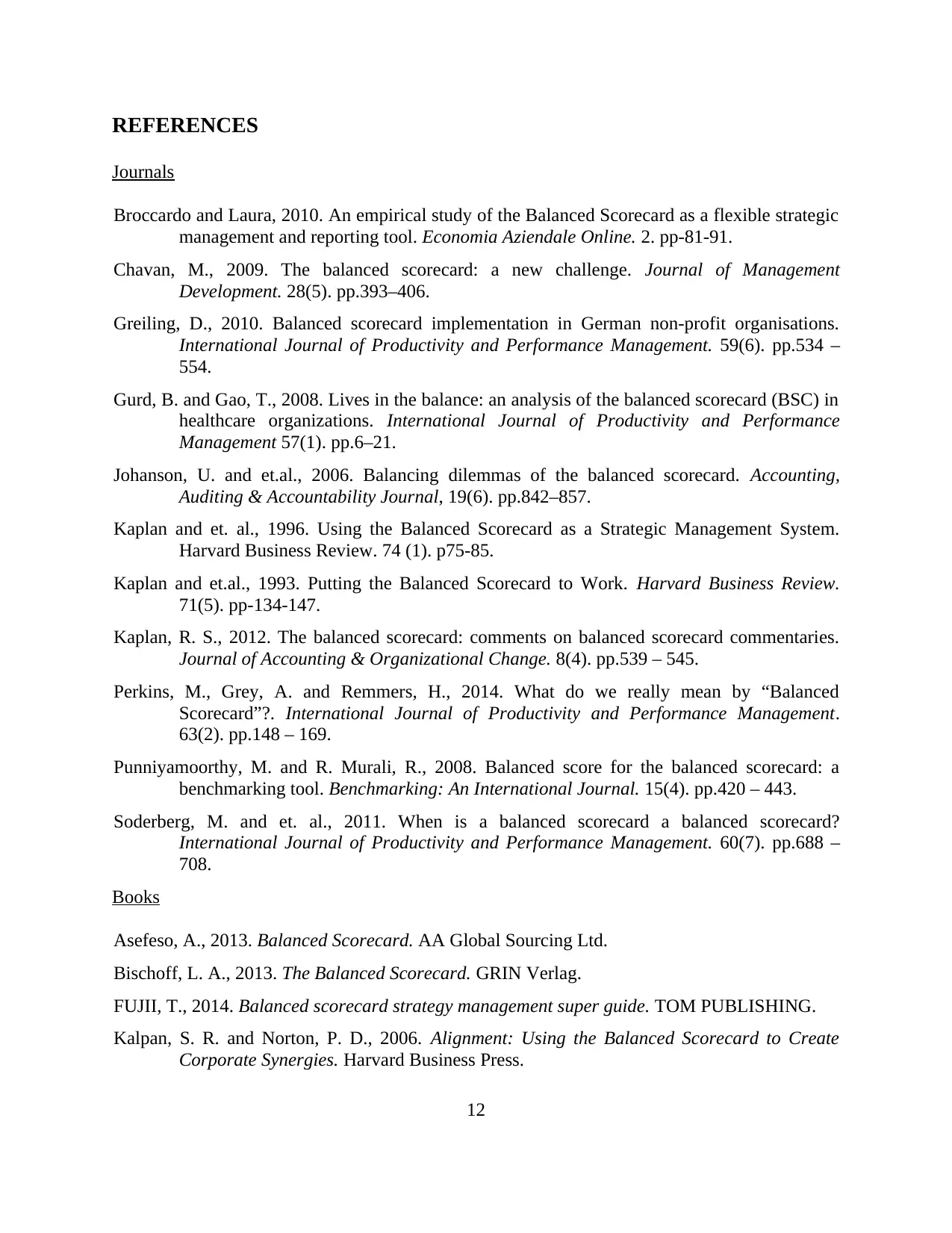
REFERENCES
Journals
Broccardo and Laura, 2010. An empirical study of the Balanced Scorecard as a flexible strategic
management and reporting tool. Economia Aziendale Online. 2. pp-81-91.
Chavan, M., 2009. The balanced scorecard: a new challenge. Journal of Management
Development. 28(5). pp.393–406.
Greiling, D., 2010. Balanced scorecard implementation in German non‐profit organisations.
International Journal of Productivity and Performance Management. 59(6). pp.534 –
554.
Gurd, B. and Gao, T., 2008. Lives in the balance: an analysis of the balanced scorecard (BSC) in
healthcare organizations. International Journal of Productivity and Performance
Management 57(1). pp.6–21.
Johanson, U. and et.al., 2006. Balancing dilemmas of the balanced scorecard. Accounting,
Auditing & Accountability Journal, 19(6). pp.842–857.
Kaplan and et. al., 1996. Using the Balanced Scorecard as a Strategic Management System.
Harvard Business Review. 74 (1). p75-85.
Kaplan and et.al., 1993. Putting the Balanced Scorecard to Work. Harvard Business Review.
71(5). pp-134-147.
Kaplan, R. S., 2012. The balanced scorecard: comments on balanced scorecard commentaries.
Journal of Accounting & Organizational Change. 8(4). pp.539 – 545.
Perkins, M., Grey, A. and Remmers, H., 2014. What do we really mean by “Balanced
Scorecard”?. International Journal of Productivity and Performance Management.
63(2). pp.148 – 169.
Punniyamoorthy, M. and R. Murali, R., 2008. Balanced score for the balanced scorecard: a
benchmarking tool. Benchmarking: An International Journal. 15(4). pp.420 – 443.
Soderberg, M. and et. al., 2011. When is a balanced scorecard a balanced scorecard?
International Journal of Productivity and Performance Management. 60(7). pp.688 –
708.
Books
Asefeso, A., 2013. Balanced Scorecard. AA Global Sourcing Ltd.
Bischoff, L. A., 2013. The Balanced Scorecard. GRIN Verlag.
FUJII, T., 2014. Balanced scorecard strategy management super guide. TOM PUBLISHING.
Kalpan, S. R. and Norton, P. D., 2006. Alignment: Using the Balanced Scorecard to Create
Corporate Synergies. Harvard Business Press.
12
Journals
Broccardo and Laura, 2010. An empirical study of the Balanced Scorecard as a flexible strategic
management and reporting tool. Economia Aziendale Online. 2. pp-81-91.
Chavan, M., 2009. The balanced scorecard: a new challenge. Journal of Management
Development. 28(5). pp.393–406.
Greiling, D., 2010. Balanced scorecard implementation in German non‐profit organisations.
International Journal of Productivity and Performance Management. 59(6). pp.534 –
554.
Gurd, B. and Gao, T., 2008. Lives in the balance: an analysis of the balanced scorecard (BSC) in
healthcare organizations. International Journal of Productivity and Performance
Management 57(1). pp.6–21.
Johanson, U. and et.al., 2006. Balancing dilemmas of the balanced scorecard. Accounting,
Auditing & Accountability Journal, 19(6). pp.842–857.
Kaplan and et. al., 1996. Using the Balanced Scorecard as a Strategic Management System.
Harvard Business Review. 74 (1). p75-85.
Kaplan and et.al., 1993. Putting the Balanced Scorecard to Work. Harvard Business Review.
71(5). pp-134-147.
Kaplan, R. S., 2012. The balanced scorecard: comments on balanced scorecard commentaries.
Journal of Accounting & Organizational Change. 8(4). pp.539 – 545.
Perkins, M., Grey, A. and Remmers, H., 2014. What do we really mean by “Balanced
Scorecard”?. International Journal of Productivity and Performance Management.
63(2). pp.148 – 169.
Punniyamoorthy, M. and R. Murali, R., 2008. Balanced score for the balanced scorecard: a
benchmarking tool. Benchmarking: An International Journal. 15(4). pp.420 – 443.
Soderberg, M. and et. al., 2011. When is a balanced scorecard a balanced scorecard?
International Journal of Productivity and Performance Management. 60(7). pp.688 –
708.
Books
Asefeso, A., 2013. Balanced Scorecard. AA Global Sourcing Ltd.
Bischoff, L. A., 2013. The Balanced Scorecard. GRIN Verlag.
FUJII, T., 2014. Balanced scorecard strategy management super guide. TOM PUBLISHING.
Kalpan, S. R. and Norton, P. D., 2006. Alignment: Using the Balanced Scorecard to Create
Corporate Synergies. Harvard Business Press.
12
⊘ This is a preview!⊘
Do you want full access?
Subscribe today to unlock all pages.

Trusted by 1+ million students worldwide
1 out of 13
Related Documents
Your All-in-One AI-Powered Toolkit for Academic Success.
+13062052269
info@desklib.com
Available 24*7 on WhatsApp / Email
![[object Object]](/_next/static/media/star-bottom.7253800d.svg)
Unlock your academic potential
Copyright © 2020–2025 A2Z Services. All Rights Reserved. Developed and managed by ZUCOL.





